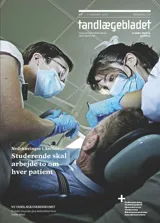Immediat indsættelse af enkelt-tandsimplantater i privat praksis
Immediat indsættelse af implantater var karakteriseret ved høj overlevelse af implantater og den endelige implantatkrone, sunde periimplantære væv og et særdeles tilfredsstillende æstetisk behandlingsresultat. Den eneste hyppigt forekommende komplikation var løsning af den provisoriske krone.
Formål
At vurdere behandlingsresultat og patienttilfredshed efter immediat indsættelse af enkelttandsimplantat og cementering af en provisorisk krone i samme behandlingsseance, hvor behandlingen var blevet foretaget i privat praksis.
Materiale og metode
I alt 55 patienter med 55 enkelttandsimplantater blev inkluderet i undersøgelsen. Behandlingen involverede tandekstraktion, implantatindsættelse, påsætning af et endeligt, individuelt abutment og en provisorisk krone i samme behandlingsseance. Den endelige krone blev efterfølgende påsat efter en gennemsnitlig opfølgningsperiode på syv måneder. Evaluering af behandlingsresultatet efter en gennemsnitlig observationsperiode på 33 måneder omfattede følgende parametre: Implantatoverlevelse, overlevelse af endelig krone, pochedybde, blødning ved pochemåling, marginalt knogleniveau og forekomst af biologiske og mekaniske komplikationer. Endvidere blev æstetiske parametre vurderet af både patienter og behandlere.
Resultater
Overlevelsen af implantatet og den endelige krone var henholdsvis 98 % og 100 %. Der blev observeret sunde marginale væv og minimale ændringer af knogleniveauet svarende til såvel implantater som nabotænder. Løsning af den provisoriske krone i helingsperioden forekom hos 33 patienter. Der var generel stor patienttilfredshed. Såvel patienter som behandlere vurderede, at der var opnået et særdeles tilfredsstillende æstetisk behandlingsresultat. Dog var den professionelle vurdering mere kritisk end patienternes vurdering.
Konklusion
Immediat indsættelse af implantater var karakteriseret ved høj overlevelse af implantater og den endelige implantatkrone, sunde periimplantære væv og et særdeles tilfredsstillende æstetisk behandlingsresultat. Den eneste hyppigt forekommende komplikation var løsning af den provisoriske krone.
Immediate placement of single-tooth implants in private practice
Aim – To assess the treatment outcome and patient satisfaction after immediate placement and provisionalization of single-tooth implants in the same visit in private practice.
Materials and methods – A total of 55 patients with 55 single- tooth implants were included in the study. The treatment involved tooth extraction, implant placement, placement of a definitive, individual abutment, and a provisional crown in the same visit. The definitive crown was placed after a mean period of 7 months. The outcome measures after a mean follow-up period of 33 month included the following parameters: Implant survival, definitive implant crown survival, probing depth, bleeding on probing, marginal bone level, and occurrence of complications. Furthermore, a subjective and professional evaluation of the esthetic outcome was performed.
Results – Implant survival and definitive crown survival were 98% and 100%, respectively. Healthy marginal tissues and minute bone level changes were observed around implants as well as the neighbouring teeth. Loosening of the provisional crown in the healing period occurred in 33 patients. The patient satisfaction was in general high. Both the patient and professional evaluation revealed a highly satisfactory esthetic treatment outcome. However, the evaluation of patients was more positive than the evaluation of the professionals.
Conclusions – Immediate implant placement was characterized by high survival of the implant as well as the definitive implant crown, healthy periimplant tissues, and a highly satisfactory aesthetic treatment outcome. The only frequently occurring complication was provisional crown loosening.


